I was really sorry to leave the Loikaw Lodge. It's new, only open about eight months but the lady owner, Swe Yi Myat, has incorporated all the features that have impressed her in her own travels and, for me, the result was perfect. Everybody was keen to make me comfortable, everything worked and the views over the small lake made a peaceful environment, although the hotel is conveniently situated in a residential area of Loikaw.
My guide Thandar Oo and the driver collected me at 8.30 a.m. and we set off along Route 54, retracing our arrival route From Heho. As we left the city, I spotted the small commercial airport, followed by major construction work which appeared to be a serious extension to the runway.
We passed a Christian church. I couldn't tell whether Catholic or Baptist (both are active in Myanmar) but it had two white towers, each topped by a short blue spire, so Catholic is more likely.
Once out of the city, we crossed a plain with rice fields on both sides, followed by a concrete river bridge. The river is presumably the water source to irrigate the healthy, green rice fields where a number of farmers could be seen working. An earlier, steel truss road bridge stood alongside the concrete bridge.
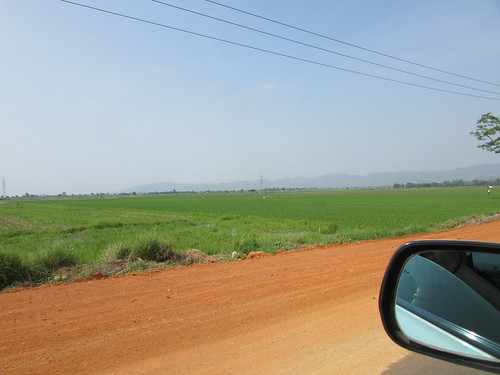
Rice-growing near Loikaw.
We passed an area of Government-owned teak trees, still quite young. Each tree had a white ring painted on the trunk, to indicate that unauthorised felling was likely to result in incarceration for the miscreant.
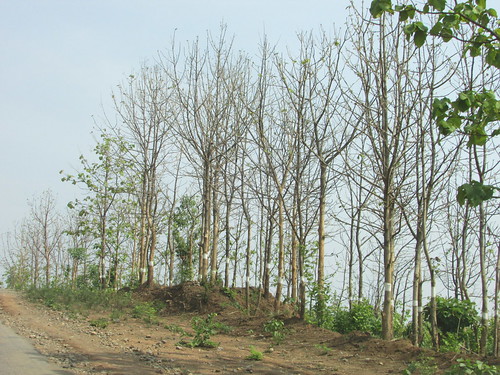
Government-owned young teak trees.
. A massive, ragged outcrop of rock had attracted the building of a host of gold-painted pagodas and the rock itself was painted white resulting in quite an impressive effect, although not on the scale of Taung Kwe Zedi in Loikaw.

A rock outcrop Buddhist shrine.
On our left, a tall, steep-sided mountain was topped with a white and gold pagoda but lower down the rock face, a Christian cross had been painted, as it appeared to me, defiantly.
Shortly after, entering Phe Khong town, we passed a large building, perhaps a school, with Catholic embellishments. Here, the unfenced single-line railway line from Loikaw had come very close to the road so each building on that side was isolated from the main road by the railway track and had built its own, rather informal, level crossing to reach the main road. The railway then ducked out of site as we passed through the main part of the town which included another church, this time with a single tower and spire surmounted by a large cross.
The railway then re-appeared on our left and, hidden in the trees, was a small station. We stopped so that I could make a photographic record.

Phe Khong station (road side).
The facilities were very modest - a simple station building, single platform and passing loop. Thandar Oo noted the ticket prices displayed in the deserted ticket hall:-
To the new capital, Nay Pyi Taw:But road and rail were not the only transport options at Phe Khong. At its southern extremity, Inle Lake discharges into a system of lakes and rivers which extends to Loikaw. Small boats provide passenger and freight facilities between Inle and Loikaw and Phe Khong is one of the intermediate calling points. So, after I'd finished my examination of the railway station, we drove to Phe Koung Jetty.
2,500 Kyats Ordinary Class, 3,350 Kyats Upper Class.
To Kalaw (our destination that day): 1,200 Kyats Ordinary Class, 1,600 Kyats Upper Class.
'Jetty' was rather overstating the infrastructure - there's a beach and the elegant wooden boats get as close as they can to dry land. I did see a decrepit-looking short wooden walkway which is perhaps intended for passengers but the activity in the short time we were there was all freight-related.
First, one of the basic but effective small Chinese-built lorries arrived. These improbable-looking machines are everywhere - four-wheeled and articulated with a noisy diesel engine on the front unitt whilst the load is carried on two rear wheels in a simple, tiny lorry body. The driver perches on a padded shelf attached to the front of the lorry body, wrestling the steering wheel on the front unit. I say 'wrestling' because the direction of these vehicles always seems rather uncertain but they are ubiquitous and carry out prodigious haulage feats. I'm told they're called "Chinese Buffalo" which seems appropriate.
The driver of this interesting vehicle turned it around and unhesitatingly backed into the lake, with an assistant sitting on each rudimentary mudguard over the rear wheels, until he reached a waiting boat lying broadside-on to the beach. Everybody involved then started to transfer a load of building bricks from the lorry to the boat.
Another "Chinese Buffalo" arrived and made a different manoeuvre, driving forwards into the water parallel to the shoreline, then attempting to reverse to reach a another boat lying perpendicular to the shoreline, partially-beached.
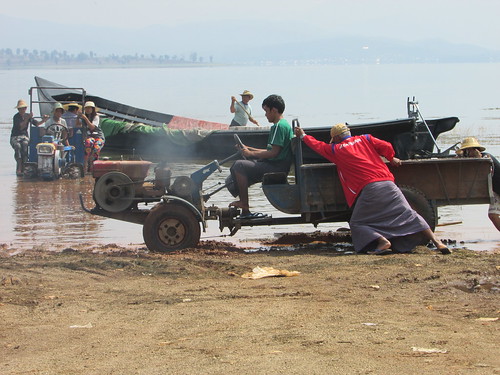
Phe Khong Jetty: One lorry, deep in the water has positioned by a waiting boat whilst a second lorry struggles in the wet sand to get near a second boat.
This positioning was achieved only after a lot of heaving from the driver's two assistants. A large sheet of tough, woven polypropylene had been laid across the hull of the beached boat and the men started shovelling gravel from the lorry onto the sheet.
The third vehicle to appear was a motor tricycle. These vehicles can be seen all over Myanmar, acting as taxis or freight hauliers. But I was surprised to see the driver reverse his machine into the water until it covered the rear axle. He then called to a boatman some yards away who poled his craft across to the motor tricycle and, once lined up, a variety of goods were moved from the motor tricycle to the boat.
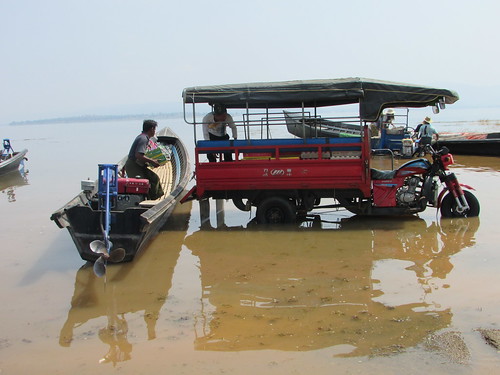
Phe Khong Jetty: A motor tricycle transfers goods to another boat.
The many motor boats I could see appeared to be of the same general pattern, wooden framed and clad with thick, flush planking, perhaps 25 feet long and 8 foot beam across the gunwhales at the widest point fitted with simple, low decking near the keel. The hull shape was elegant and suggested speed.
Whereas many of the smaller motor boats I've seen in the Far East have been of the 'long-tail' pattern, these motor boats had a fixed diesel engine driving a propeller shaft which passed through the transom to a universal joint driving the propeller itself through a secondary shaft. This allowed a lever mechanism incorporating a tiller to steer the boat and lift the propeller out of the water when required. Seen on the water, these craft seemed to have a fair turn of speed.
We then walked to the nearby market. It was a large market, well provided with permanent, lock-up stalls. Although only partly in use during our visit, there was still the usual bewildering variety of food and dry goods on offer.
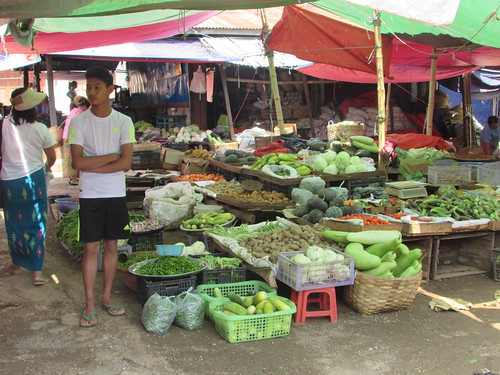
Phe Khong Market.
Our car continued north through the rugged mountain scenery of Pa-O territory which I found most appealing. We made another stop at Pin Kun Village, with a typical Pa-O market still in progress where the Pa-O come to sell their produce and purchase necessities.
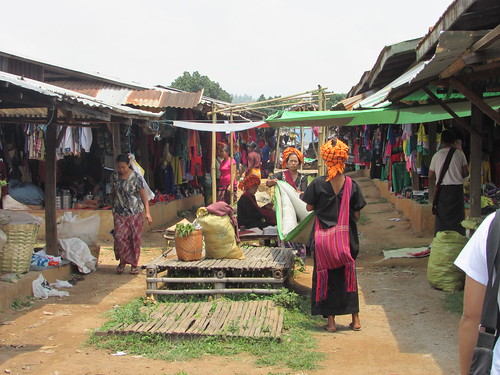
Pin Khun Market: Note the traditionally-dressed Pa-O women in black, with orange 'turbans'.
Thandar Oo had presented me with a Kayah longyi which needed tapes fitting (for the fuller European figure). She commissioned a girl at a tailoring stall equipped with two Chinese-made treadle sewing machines to do the work but, before the work was completed, ended up demonstrating her abilities as a seamstress herself.
As we returned to our car, I watched a lorry from a more remote village getting ready to leave with a group of Pa-O people.
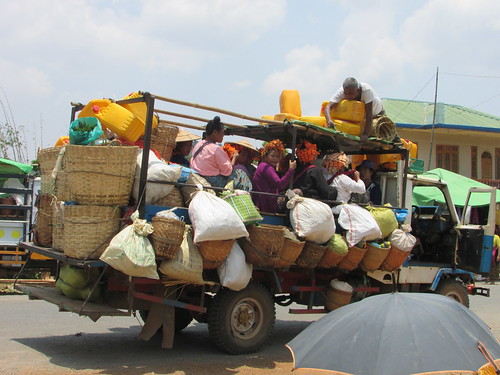
Pin Khun Market: Transactions completed, a well-loaded lorry prepares to return Pa-O people to their village.
We continued towards Kalaw and, about 20 minutes later, passed through another village where the railway ran down the side of the street.
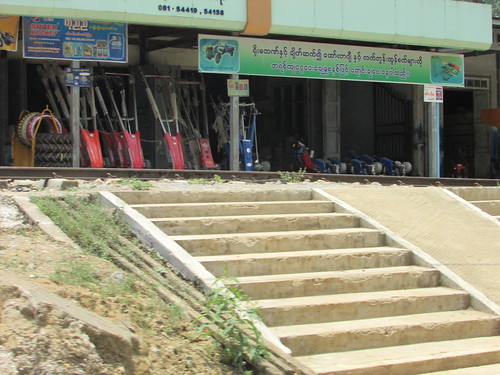
Loikaw - Aung Ban railway track passing in front of a row of shops. Although broad concrete steps are provided here from the main road, pedestrians then have to step over the rails!
When we came to the junction with the road to Heho, we turned towards Kalaw, pausing at the railway station to re-check the timing for our proposed railway journey the following day. Finally, it was on to the comfort of the Kalaw Hill Hotel for one night.
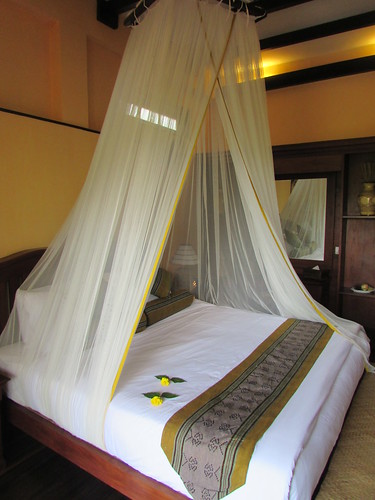
Kalaw Hill Lodge Hotel.
I'd first stayed there just over a year earlier. That first visit is described in the post By train to Kalaw with a link to the following post and to the pictures of that first visit.
Related Posts on this Website
Next Post describing this trip.
All Burma-2017 Trip posts.
My Pictures
Where necessary, clicking on an image above will display an 'uncropped' view or, alternately, pictures from may be selected, viewed or downloaded, in various sizes, from the album listed:-
Loikaw Lodge.
Aung Ban - Loikaw by road.
Aung Ban to Loikaw railway.
Phe Khong Jetty.
Phe Khong Market.
Pin Kun Market.
Kalaw Hill Lodge.
[Links to pictures added 24-May-2017: Pictures added, minor text changes 2-Sep-2017]
